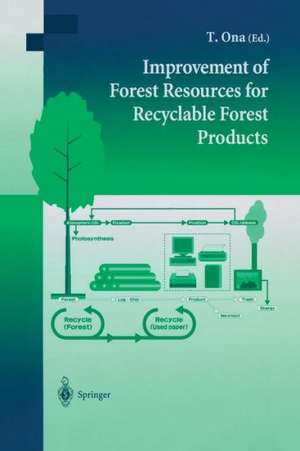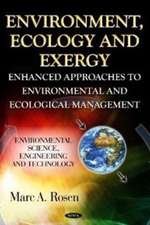Improvement of Forest Resources for Recyclable Forest Products
Editat de T. Onaen Limba Engleză Paperback – 7 dec 2012
| Toate formatele și edițiile | Preț | Express |
|---|---|---|
| Paperback (1) | 635.80 lei 43-57 zile | |
| Springer – 7 dec 2012 | 635.80 lei 43-57 zile | |
| Hardback (1) | 642.03 lei 43-57 zile | |
| Springer – 26 mar 2004 | 642.03 lei 43-57 zile |
Preț: 635.80 lei
Preț vechi: 748.00 lei
-15% Nou
Puncte Express: 954
Preț estimativ în valută:
121.66€ • 127.34$ • 101.26£
121.66€ • 127.34$ • 101.26£
Carte tipărită la comandă
Livrare economică 31 martie-14 aprilie
Preluare comenzi: 021 569.72.76
Specificații
ISBN-13: 9784431679684
ISBN-10: 4431679685
Pagini: 204
Ilustrații: XI, 188 p.
Dimensiuni: 155 x 235 x 11 mm
Greutate: 0.29 kg
Ediția:Softcover reprint of the original 1st ed. 2004
Editura: Springer
Colecția Springer
Locul publicării:Tokyo, Japan
ISBN-10: 4431679685
Pagini: 204
Ilustrații: XI, 188 p.
Dimensiuni: 155 x 235 x 11 mm
Greutate: 0.29 kg
Ediția:Softcover reprint of the original 1st ed. 2004
Editura: Springer
Colecția Springer
Locul publicării:Tokyo, Japan
Public țintă
Professional/practitionerCuprins
Overview of the Project “Development of Forest Resources with High Performance for Paper Recycling”.- Near Infrared Spectroscopy: A Tool for the Rapid Estimation of Wood Properties.- Forest Diversity and Pulp Quality: Some Tools for Wooden Raw Material Strategies for the Pulp Paper Industry.- Feasibility Study of Tree Selection for High Pulp Yield, Brightness and Recyclable Chemithermomechanical Paper Production Using Eucalyptus globulus.- Toward the Construction of an Efficient Link Between Forest Recycling and Paper Recycling Using Trees with High Performance for Paper Recycling.- Chemical Aspects of Photo-Yellowing of High-Yield Pulps.- Production of High Brightness CTMP from Eucalyptus globulus and Their Light-Induced Color Reversion.- Characterization of Photo-Yellowing Trigger Compounds Repressing Paper Recyclability of Eucalyptus globulus by Pyrolysis-GC/MS.- Fiber Properties and Papermaking Potential of Recycled Acacia Pulp.- The Impact of Chemical Composition of Pulp Fiber Cell Wall on Paper Recycling Potential of Fibers.- Limitation of Fiber Fractionation-Refining Process to Improve Paper Strength Using Recycled OCC Pulp.- Refining Treatment Could Contribute to Restoring the Strength Properties of OCC Pulp.- Formation and Structure of Reaction Wood Fibers Forming No G-Layer in Some Hardwood Species.- Radial Variation of Cell Morphology in Three Acacia Species.- Within-Tree Variation of Detailed Fiber Morphology and Its Position Representing the Whole-Tree Value in Eucalyptus camaldulensis and E. globulus.- Within-Tree Variation of Vessel Morphology and Frequency and Representative Heights for Estimating the Whole-Tree Values in Eucalyptus camaldulensis and E. globulus.- Representative Heights Assessing Whole-Tree Values and the Within-Tree Variations ofDerived Wood Properties in Eucalyptus camaldulensis and E. globulus.- Rapid Assessment of Vessel Morphology by Pyrolysis-Gas Chromatography.- Assessment of Vessel Anatomical Features in Eucalyptus camaldulensis by Pyrolysis-Gas Chromatography.- Rapid Characterization of Total Fatty Acids in Wood by Reactive Thermal Desorption-Gas Chromatography with Tetrabutylammonium Hydroxide.- Effect of Deuterium Exchange in Lignin on Its Structural Analysis Using FT-Raman Spectroscopy.- Direct Analysis of Condensed Tannins in Bark by Matrix-Assisted Laser Desorption/Ionization Mass Spectrometry Combined with Solid Sample Preparation.- Tannin and Related Polyphenolic Components from Tropical Tree Spcies.- Characterization of Natural Resin Shellac by Reactive Pyrolysis-Gas Chromatography.- Conversion Pattern of Lignocellulosics in the Phase-Separation System.- An Essay on the Fine Structure of the Wood Cell Wall Related to the Physical Properties of the Recycled Paper.- Wood Qualities of Some Tropical Plantation Species — Does Hastening the Growth Debase the Quality?.- Research on Efficient Use of Forest Products — Engineering Evaluation of Good Tactile Warmth for Wood.- Possible Effects of Properties in Polyphenol Oxidases on Rooting Ability of Eucalyptus camaldulensis Cutting Shoots.- Stable Isotope Tracer Experiments Give Strong Evidence Supporting a Controversial Pathway in Lignin Biosynthesis.- Characterization of Potassium Channels from Arabidopsis thaliana.- A New Combination Device Comprised of Surface Plasmon Resonance and Fluorescence Microscopy for a Rapid Screening of Anticancer Phenolic Compounds.- The Feasibility of a Biotest Battery Applicability to Construct an Early Warning System for Leachate from Solid Wastes and Recycled Materials.- List of Authors.
Caracteristici
Includes newly developed techniques such as Automatic tree selection devices for high yield of recyclable strong pulp and low color reversion papers Analytical methods (from anatomical, chemical, physical, or biochemical aspects) of wood for improvement of recyclable products New products from trees for various industries (ex. Developing anti-cancer drug and tree selection device for the drug)














